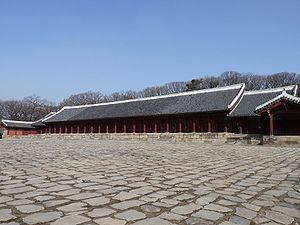- Jongmyo
-
Jongmyo Shrine * UNESCO World Heritage Site
Country Republic of Korea Type Cultural Criteria iv Reference 738 Region ** Asia-Pacific Inscription history Inscription 1995 (19th Session) * Name as inscribed on World Heritage List
** Region as classified by UNESCOJongmyo Hangul 종묘 Hanja 宗廟 Revised Romanization Jongmyo McCune–Reischauer Chongmyo Jongmyo is a Confucian shrine dedicated to the memorial services for the deceased kings and queens of the Korean Joseon Dynasty. According to UNESCO, the shrine is the oldest royal Confucian shrine preserved and the ritual ceremonies continue a tradition established since the 14th century. Such shrines existed during the Three Kingdoms of Korea period but only the shrines for the rulers of Joseon remain. The Jongmyo Shrine was added to the UNESCO World Heritage list in 1995.
Contents
History
When it was built in 1394 by order of King Taejo, it was thought to be one of the longest buildings in Asia, if not the longest. The main hall, known as Jeongjeon, had seven rooms. Each room was reserved for a king and his queen. The complex was expanded by King Sejong who ordered the construction of Yeongnyeongjeon (Hall of Eternal Comfort). This practice of expansion continued, with the growth of the complex moving from west to east, because of the need to house more memorial tablets during the reigns of later kings until there were a total of nineteen rooms. However, during the Seven-Year War, Japanese invaders burned down the original shrine and a new complex was constructed in 1601 CE which has survived to this day. The original tablets were saved in the invasion by hiding them in the house of a commoner and also survive to this day. [1]. There are 19 memorial tablets of kings and 30 of their queens, placed in 19 chambers. Each room is very simple and plain in design. Only two kings' memorial tablets are not enshrined here.[2].
The current Jeongjeon is National treasure of Korea No. 227 and is the longest building in Korea of traditional design.[3].
The south entrance gate was reserved for spirits to enter and exit, the east gate was for the king, and the west gate was for the performers of the royal ritual.[4].
Viewed from the king's throne at Gyeongbokgung Palace, Jongmyo Shrine would have been on the king's left while the Sajik Shrine, another important Confucian shrine, was on the right. This arrangement was derived from Chinese practice. The main halls are surrounded by hills. In front of the main hall is the Woldae Courtyard, which is 150 meters in length and 100 meters in width.
Jongmyo Structure
The Jongmyo Shrine is divided into 15 main parts. Jung Moon -정문- (Front Gate), 'Mang-Myo Ru', 'Gong-min Wang' Shrine, 'Hyang-Dae Chung' 'Uh-sook' Room (shil), 'Panwi Dae', 'Jun-Sa Chung'
Jung Moon -정문- (Main Gate)
The main entrance to the whole shrine sits here.
Mang Myo Ru [망묘루]
Jongmyo jeryeak
See also: Jongmyo Jerye#Jerye-akAn elaborate performance of ancient court music (with accompanying dance) known as Jongmyo jeryeak (hangul: 종묘제례악; hanja: 宗廟祭禮樂) is performed there each year for the Jongmyo jerye ritual. Musicians, dancers, and scholars would perform Confucian rituals, such as the Jongmyo Daeje (Royal Shrine Ritual) in the courtyard five times a year. [5]. Today the rituals have been reconstructed and revived. The Jongmyo Daeje has been designated as Important Intangible Cultural Property No. 56 and is performed every year in May. [6]. The Jongmyo Jerye-ak, the traditional court music of Joseon, is performed by the Royal Court Orchestra and has been designated as Important Intangible Cultural Property of South Korea No. 1.[7]. This court music has its origins in Chinese court music that was brought to Korea during the Goryeo period. [8]. King Sejong composed new music for the ritual based largely on hyangak (with some dangak) in 1447 and 1462. [9].
Transportation
Jongmyo entry is located 155 Jong-no, Jongno-gu. The nearest subway station is
- Jongno 3-ga Station (Station #130 on Line 1, Station #329 on Line 3, Station #534 on Line 5).
See also
- Korean Buddhist temples
- National treasures of Korea
- Munmyo
- List of Korea-related topics
External links
- Official website
- UNESCO Jongmyo shrine
- UNESCO Masterpiece of the Oral and Intangible Heritage of Humanity Jongmyo Daeje ceremony
- Jongmyo Jeryeak : Official Seoul City Tourism
- Jongmyo Shrine : Official Site of Korea Tourism Org
- Life in Korea: Jongmyo
- Asian Historical Architecture: Jongmyo
World Heritage Sites in South Korea World Heritage Sites Changdeokgung Palace Complex · Gochang, Hwasun and Ganghwa Dolmen Sites · Gyeongju Historic Areas · Haeinsa Temple Janggyeong Panjeon, the Depositories for the Tripitaka Koreana Woodblocks · Historic Villages of Korea: Hahoe and Yangdong · Hwaseong Fortress · Jeju Volcanic Island and Lava Tubes · Jongmyo Shrine · Royal Tombs of the Joseon Dynasty · Seokguram Grotto and Bulguksa Temple
Tentative Lists Ancient Mountain Fortresses in Central Korea · Daegokcheon Stream Petroglyphs · Gangjingun Kiln Sites · Gongju and Buyeo Historic Sites · Iksan Historic Areas · Mt. Soraksan Nature Reserve · Naganeupseong, Town Fortress and Village · Namhansanseong - Ancient Fortified Military and Cultural Landscape of Mt. Namhansan · Oeam Village · Salterns · Sites of fossilized dinosaurs across the southern South Korean coast · Southwestern Coast Tidal Flats · Upo wetlandCoordinates: 37°34′29″N 126°59′38″E / 37.57472°N 126.99389°E
Categories:- Jongno-gu, Seoul
- World Heritage Sites in South Korea
- National Treasures of South Korea
- 1394 establishments
- Masterpieces of the Oral and Intangible Heritage of Humanity
- Visitor attractions in Seoul
- Important Intangible Cultural Properties of South Korea
- Korean Confucianism
Wikimedia Foundation. 2010.

